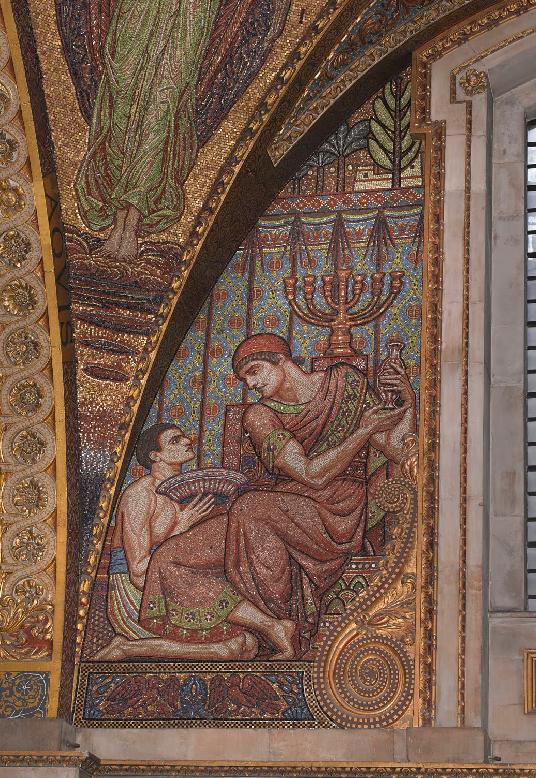
Parashat Pekudei
♦
Parashat Pekudei
Minerva Generalao
March 6, 2019
This week’s Torah portion continues the narrative on the building of the tabernacle, a portable shrine to house the Ark and the Tablets of the Covenant. It also gives a detailed accounting of the metals used in building the tabernacle (Ex 38:21-31), the materials and processes in making the priestly vestments (39:1-31), the completion and inspection of the tabernacle (vv. 32-43) and assembly and dedication (40:1-15). The parashah closes the Book of Exodus with the appearance of the Divine Presence (vv. 34-38).
This is a long reading that moves from the very material and physical to the utterly divine and glorious. The accounting of the gold, silver and bronze used and the detailed description of the materials and processes to make the vestments made me think that the parashah feels like one of the earliest versions of a chief executive officer’s (CEO) report to the stockholders or a president’s state of the nation address. Why do we have the accounting by Moses? Perhaps this is we now call transparency. A comment in Etz Hayim suggests that the details are show that leaders of a community must be above any suspicion of personal gain. Some Israelites feared that they themselves would have taken advantage had they been given the chance to handle precious metals and must have suspected Moses to be no better than them. To avoid suspicion, the family who prepared the incense for the Temple services would never let their relatives wear perfume so people would not suspect them of using Temple incense for personal use. So as not to be suspected of pocketing public funds, the official in charge of temple offering would wear a special garment with no pockets and no long sleeves.
A marker for the completion of a task is the phrase “just as the Lord commanded Moses.” In the section on the making of the vestments, from “They make the sacred vestments for Aaron, as the Lord had commanded Moses” (39:1) to “The Israelites had done everything just as the Lord had commanded” (39: 33), the phrase appears seven times: upon the completion of the making of the ephod, the breastplate, robe of the ephod and the diadem (vv. 5, 7, 21 ,26, 29, 31, 32). The repetition indicates how important it is to follow God’s mitzvot (commandments).
There is a hierarchy here: From God, to Moses, to the people and the priests. Or is it from God, to Moses, to priests and to the people? What is clear is that we are in the end accountable to God. To make this possible, we should also listen to the Moses and to the Aaron of our times. But our priests, rabbis, pastors or imams must also listen to the people so they can properly communicate God’s commands.
After the hard work, there is the good news of blessings. “When Moses saw that they had done all the work just as the Lord had commanded, he blessed them” (v. 43). And there’s the best news of the presence of God – “the glory of the Lord filled the tabernacle” (40:34) and “the cloud of the Lord was on the tabernacle by day, and fire was in the cloud by night, before the eyes of all the house of Israel at each stage of their journey” (40:38). This moment is very important because from then on God resides in the midst of his people as He accompanies and guides them (40:38). God accompanies us during our own Sinai and wilderness times. When we move on from a good or bad time in our life, we are assured of God’s presence.
Reflection and Discussion: [1] Describe a happy or sad time in your life when you had truly felt the presence of God. [2] Have you experienced a time when you felt that following God’s commands was not easy? Which do you think should come first: accounting to men or accounting to God?
Bibliography: Etz Hayim: Torah and Commentary (New York, 2001); Ska, Introduction to Reading the Pentateuch (Rome/Indiana, 2006); Gilah Langner, “Keeping Accounts,” myjewishlearing.com (https://www.myjewishlearning.com/article/keeping-accounts/)

Bezaleel – Sir William Blake Richmond, 1891/1904
Source: Google Arts & Culture

This week’s teaching commentary is by
Minerva Generalao,
Philippines, Bat Kol 2014
PLEASE NOTE: The weekly Parashah commentaries represent the research and creative thought of their authors, and are meant to stimulate deeper thinking about the meaning of the Scriptures. While they draw upon the study methods and sources employed by the ISPS-Ratisbonne, the views and conclusions expressed in these commentaries are solely those of their authors, and do not necessarily represent the views of ISPS-Ratisbonne. The commentaries, along with all materials published on the ISPS-Ratisbonne website, are copyrighted by the writers, and are made available for personal and group study, and local church purposes. Permission needed for other purposes. Questions, comments and feedback are always welcome.
Share this with your friends
Share on facebook
Share on google
Share on twitter
Share on whatsapp
Institute Saint Pierre de Sion – Ratisbonne – Christian Center for Jewish Studies
Congregation of the Religious of Our Lady of Sion
Contact us:
secretary@ratisbonne.org.il
26 Shmuel Ha-Naguid Street – Jerusalem
Subscribe to Newsletter

No responses yet